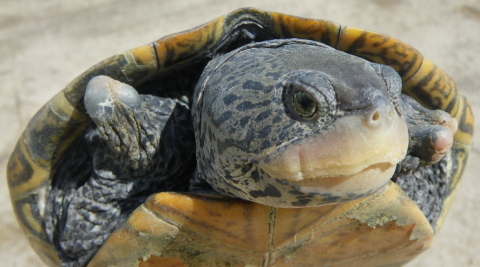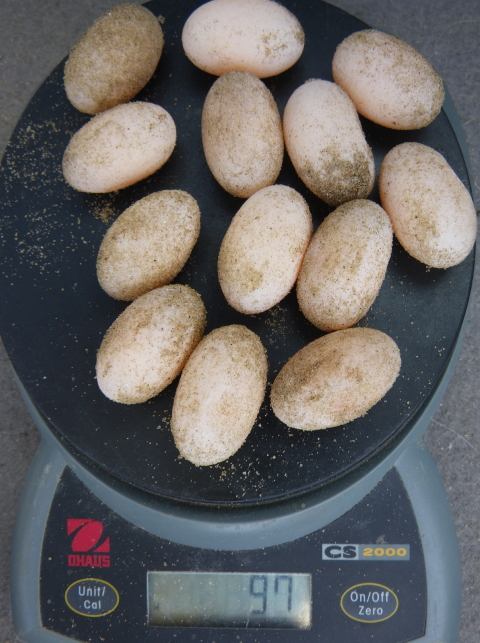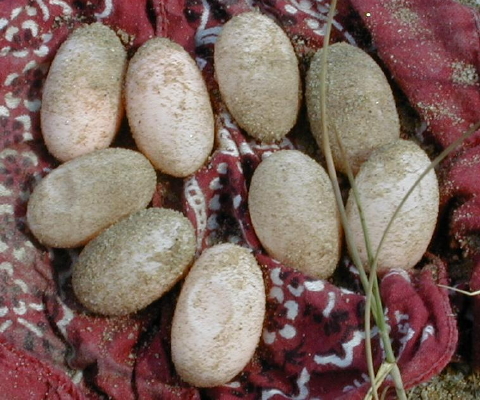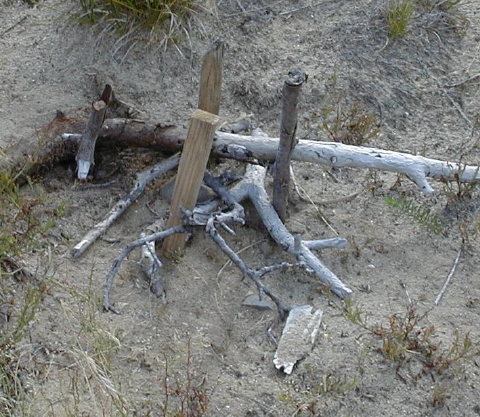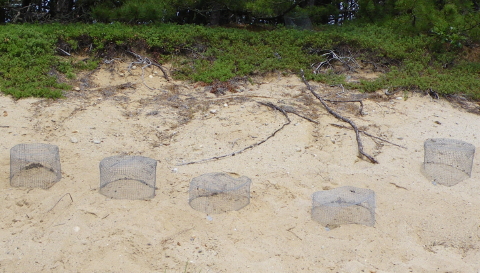Terrapin #365 Missing Both Front Limbs
With a mixture of anger and joy, Don Lewis of Turtle Journal welcomed the return of Diamondback Terrapin #365 to Lieutenant Island on Sunday. This female terrapin has been under observation by the terrapin research project for 15 years, and Don has personally watched her nesting at Turtle Point since July 2000, when her nest became the first ever protected on Cape Cod. When she was last seen in May 2008 in the Fresh Brook Run mating aggregation, #365 was a perfect, healthy terrapin. Yet, as she struggled ashore to nest on Sunday, both her front limbs were missing below the joint. The wounds were healed and she compensated well enough to successfully nest, but she remained handicapped both on land and back in the water.Â
Terrapin #365 Nests on Turtle Point
She reached the shore about a quarter mile from her traditonal Turtle Point nesting site and struggled over the thick salt hay wrack. After Don examined, measured, weighed and documented her condition, he walked her to tip of Turtle Point to save her some wear, tear and energy. Terrapin #365 immediately began her nesting ritual as Don withdrew beyond her sight to witness the process. You can observe in the video sequence above how she drove her front stumps into the ground like spikes to hold herself stable while she dug the nest, deposited her eggs and covered up.
Terrapin #365’s Thirteen Perfect Eggs
From a scientific standpoint, Terrapin #365 continues to provide valuable data. We obtained her weight before nesting (1144 grams) and after nesting (1042 grams), and as can be seen above, we weighed her entire 13 egg clutch at 97 grams.Â
Terrapin #365’s Nine Eggs from July 18th, 2000
Terrapin #365, way back in July of 2000, provided the first nest that we protected to begin our decade long conservation initiative. On July 18th, she came ashore at Turtle Point, weighing 1070 grams; she dropped to 982 grams after depositing nine perfect eggs (see photo above).
Terrapin #365 – First Nest Ever Protected in July 2000
Before we built wire cages as predator excluders, we used seat-of-the-pants methods to protect nests. Terrapin #365’s nest on 18 July was the first we tried to save with a combination of driftwoord and stakes, and other more exotic procedures. Surprisingly, whether through our efforts or simple serendipity, the eggs hatched on October 10th after 83 days of incubation.
Nest Protectors (Predator Excluders) on Turtle Point (2011)
Today, of course, we are more sophisticated with PEs (predator excluders) embedded deeply into the sand and stapled to the ground. Terrapin #365’s eggs have been covered by such a nest protector on the high dune of Turtle Point.
Â
Terrapins #365 Release into Black Duck Creek
Again, to save her some wear and tear on her injured limbs, Don brought her to Black Duck Creek by the Lieutenant Island Bridge for release back into the wild. As he watched her slip into the distance, Don observed that she was having difficulty exerting enough thrust with her back legs alone to counter the strong tidal current and to dive beneath the surface. Yet, in tribute to terrapins that persist in the face of such enormous obstacles, I remember the words of broadcaster John Cameron Swayze who coined the phrase, “They take a licking and keep on ticking;” a fitting motto for these hardy critters. And, clearly, Terrapin #365 has become the new model for a species fighting for survival in a world that’s changing in ways not for the better … neither for man nor for beast.
